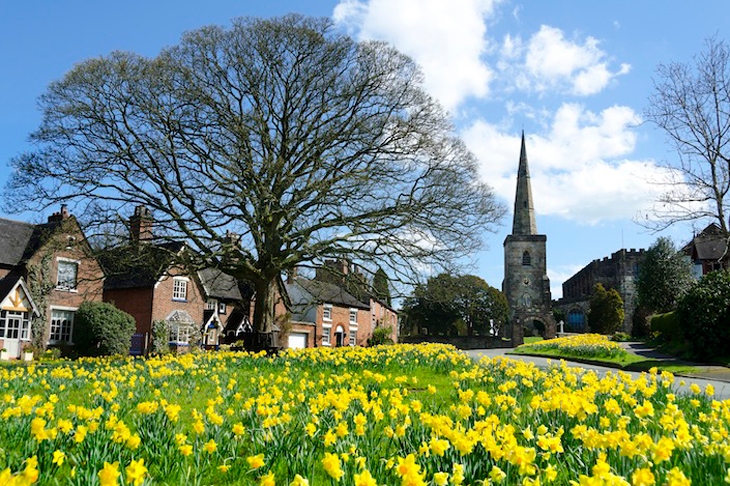The old coaching inn on the green. The Sunday morning toll of church bells. The ducklings paddling on the pond. The soft sound of leather against willow. Nothing, absolutely nothing, defines England’s idea of itself more than the sleepy rural village. World events can shake our island nation. Population growth can swell our cities. Who knows, climate change could even sink East Anglia beneath the waves. But as long as the country’s villages stand true, then England is safe and we can all put the kettle on for tea.
Utter rot, says Tom Fort, in this timely, myth-busting march through English rural history. Racing through the ages on his bicycle, the travel writer and historian — himself ‘by inclination a village type of person’ — is at pains to decry our sentimental attachment to the rural idyll. The idea of the old, simple, pre-Fall rustic England may cling on in our hearts, but it’s a ‘deathly silent sham’.
Villages were never meant to be permanent. Nor, for most of their history, were they very pleasant. Their primary purpose was to enable the land to be worked. Life was tough, amusements were few and poverty was pervasive. The idea of rootedness is similar poppycock, Fort maintains. Villagers were regularly on the move, whether running from marauding Vikings or driven off by the dreaded enclosure laws. As far back as 1751, the poet and novelist Oliver Goldsmith could lament how ‘desolation saddens all the green’ in his famous poem ‘The Deserted Village’.
The Village News makes its case with dogged determination. Each chapter is dedicated to a single village (or occasionally two), invariably with a strong literary or historic connection. A standard format quickly becomes apparent: Fort arrives pedalling on his bicycle, chats to a local or two, maybe visits the pub or the cricket pitch, then gets down to dissecting what-
ever book or event drew him there.
The result is a whistle-stop tour around non-urban England, from dormitory villages in commuterville to picture-postcard honeypots in the Cotswolds. One of the book’s joys is the host of rural writers we meet along the way — albeit, most of them are dead. Some, like Ronald Blythe and Laurie Lee, are stalwarts of the theme. Others are lesser-known writers, such as the ‘high priest of fundamentalism’ H.J. Massingham or the amateur historian Rowland Parker (who diligently charts the history of his Cambridgeshire cottage through two millennia).
While the canon of rural writing gives the book shape, Fort treats the vast majority of it as a straw man. In his view, nothing has done more to pander to the nostalgic temperament of this Sceptred Isle than its literary tradition. Tellingly, he has to turn to a Welshman for a necessary corrective. With regard to eulogistic depictions of rural England’s Golden Age, the academic and critic Raymond Williams was fond of employing the metaphor of an escalator: in whatever period such a depiction appears, Utopia is always located ‘imprecisely in the past’.
The Village News does a fine job of setting the record straight — if at somewhat greater length than is perhaps necessary. Where it really excels, however, is in its hard-edged analysis of the contemporary ramifications of the idyll myth. Travel with Fort to Askrigg (of All Creatures Great and Small fame), or Birbury (stamped on the inside cover of all UK passports) or Troutbeck (home to Wordsworth’s ‘Lakeland statesmen’) and you will find villages cursed by their prim perfection. Preserved in aspic, England’s classic villages are rooted unnaturally in time. Aesthetically flawless, they are atrophying before our eyes.
This is not true for all villages. Some are in rude health. Fort’s own village of Sonning Common in south Oxfordshire, for example, has doubled in size over the last 50 years. It is blessed with schools, a petrol station and Zumba classes in the village hall — everything a modern villager needs. Yet, even by the author’s own judgement, it is a ‘deeply unremarkable’ place. Generic 1960s estates abound. The car rules. As myth has given way to reality, so functionalism has won over form.
With the same gusto that it deconstructs the Arcadian lie, The Village News endeavours to rescue rural England from the jaws of builder-led blandness. Villages need to be allowed to grow, Fort insists. But they must do so organically and preferably by community consent. The task isn’t easy, as his own hilarious experience of drawing up a Neighbourhood Development Plan testifies. Holiday-home owners and weekenders don’t want their idea of rural bliss messed with. Tough luck, says Fort. Villages must develop or die: it’s a binary choice.
His hard truths won’t be to everyone’s liking. More time pounding the pavements might have offered a more nuanced view at times too. Yet, without question, this pedal around the parishes is an entertaining and provocative read on a subject close to every English heart.






Comments